Night Driver
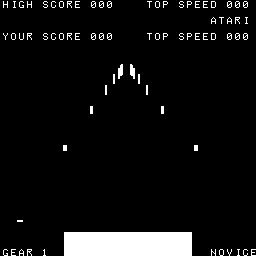 Atari introduces its first-person driving game Night Driver, the first video game to attempt to simulate depth in its display. Introduced in black & white, Night Driver will later gain even more popularity in color on Atari’s first programmable home video game system.
Atari introduces its first-person driving game Night Driver, the first video game to attempt to simulate depth in its display. Introduced in black & white, Night Driver will later gain even more popularity in color on Atari’s first programmable home video game system.
Warner Communications buys Atari
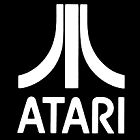 Forking over approximately $28,000,000 for the privelege of becoming a player in the video game industry, Warner Communication buys Atari, which had previously been privately owned by Nolan Bushnell and other investors. Though Bushnell remains on Atari’s board for a time, he is eventually removed and replaced by former Burlington Textiles vice president Ray Kassar. At this point, Atari’s most recent product is Atari Video Music, a device that connects to home stereo systems and television sets, producing psychedelic patterns synchronized to music; the company is spending the latter half of 1976 not releasing video game products in an attempt to sit out terms of a legal settlement with Magnavox.
Forking over approximately $28,000,000 for the privelege of becoming a player in the video game industry, Warner Communication buys Atari, which had previously been privately owned by Nolan Bushnell and other investors. Though Bushnell remains on Atari’s board for a time, he is eventually removed and replaced by former Burlington Textiles vice president Ray Kassar. At this point, Atari’s most recent product is Atari Video Music, a device that connects to home stereo systems and television sets, producing psychedelic patterns synchronized to music; the company is spending the latter half of 1976 not releasing video game products in an attempt to sit out terms of a legal settlement with Magnavox.
Fairchild VES: the first video game cartridges
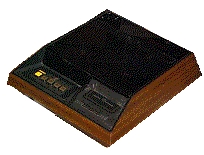 A major breakthrough in an industry that was previously dominated by expensive, bulky consoles that could only play a handful of games each, Fairchild introduces its Video Entertainment System, the first programmable video game system. Though it has several built-in games like its predecessors, the Fairchild system allows owners to add new games by purchasing “Videocarts” – roughly the size of 8-track tapes – containing additional games. Fairchild later renames its VES console Channel F to avoid market confusion with Atari’s VCS (Video Computer System), which doesn’t arrive on the scene until the following year.
A major breakthrough in an industry that was previously dominated by expensive, bulky consoles that could only play a handful of games each, Fairchild introduces its Video Entertainment System, the first programmable video game system. Though it has several built-in games like its predecessors, the Fairchild system allows owners to add new games by purchasing “Videocarts” – roughly the size of 8-track tapes – containing additional games. Fairchild later renames its VES console Channel F to avoid market confusion with Atari’s VCS (Video Computer System), which doesn’t arrive on the scene until the following year.
Coleco Telstar
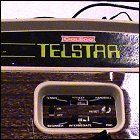 Coleco, a toy company best known for its air hockey tables, releases its first video game console, the Coleco Telstar. A self-contained unit capable of playing three variants of video tennis, Telstar retails for roughly half the price of Atari’s Pong console, and Coleco sells over a million units of Telstar in various guises and case styles through the end of the decade. In the early 1980s, Coleco begins development of its own programmable, cartridge-based successor to Telstar, which will reach the market in 1982 as Colecovision.
Coleco, a toy company best known for its air hockey tables, releases its first video game console, the Coleco Telstar. A self-contained unit capable of playing three variants of video tennis, Telstar retails for roughly half the price of Atari’s Pong console, and Coleco sells over a million units of Telstar in various guises and case styles through the end of the decade. In the early 1980s, Coleco begins development of its own programmable, cartridge-based successor to Telstar, which will reach the market in 1982 as Colecovision.
Breakout breaks out
 Atari introduces a new arcade game, Breakout, which takes the play mechanics of Pong, turns them on one side, and turns the game into a single-player endurance trial. Assigned to junior Atari employee Steve Jobs, Breakout is actually completed by Jobs’ friend Steve Wozniak, though the circuitry for the game is redesigned when Atari’s engineers can’t get their heads around Wozniak’s incredibly compact, efficient design, which reduces the number of logic circuits to a bare minimum. Jobs and Wozniak later approach Atari with a design for a personal computer, and are turned down; that design later becomes the first Apple Computer.
Atari introduces a new arcade game, Breakout, which takes the play mechanics of Pong, turns them on one side, and turns the game into a single-player endurance trial. Assigned to junior Atari employee Steve Jobs, Breakout is actually completed by Jobs’ friend Steve Wozniak, though the circuitry for the game is redesigned when Atari’s engineers can’t get their heads around Wozniak’s incredibly compact, efficient design, which reduces the number of logic circuits to a bare minimum. Jobs and Wozniak later approach Atari with a design for a personal computer, and are turned down; that design later becomes the first Apple Computer.
Atari Video Music: Atari gets groovy
 Atari gets firmly into the swing of the ’70s with a rare foray into the non-game-related consumer electronics market. Atari Video Music is a device that, when connected to home stereo systems and television sets, displays colorfully trippy random patterns in time with music or any other audio. Some settings, such as sensitivity and randomness, can be set by the user. This bizarre device, a sort of video lava lamp, somehow fails to take off, and Atari goes back to hatching ideas for video games.
Atari gets firmly into the swing of the ’70s with a rare foray into the non-game-related consumer electronics market. Atari Video Music is a device that, when connected to home stereo systems and television sets, displays colorfully trippy random patterns in time with music or any other audio. Some settings, such as sensitivity and randomness, can be set by the user. This bizarre device, a sort of video lava lamp, somehow fails to take off, and Atari goes back to hatching ideas for video games.
Games with cartridges
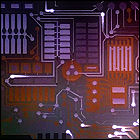 Alpex Corporation, an American computer company, files “the ‘555 Patent” for a “television display control apparatus” capable of loading software from ROM chips embedded in swappable cartridges and other media. This patent effectively shifts the infant video game industry from a hardware-based model to a software-based model, and is licensed by Fairchild Semiconductor for the first cartridge-based video game, the Fairchild Video Entertainment System (later known as Channel F), a year later; the resulting sea change forces a sudden reassessment in the R&D departments at Atari and Magnavox, among others. Due to the remarkably broad nature of patent #4026555, Alpex will be able to take nearly every video game manufacturer to court to force them to license the technology from Alpex through the early ’90s. The first major challenge to Alpex’s patent will come from Nintendo in 1986, a case that will eventually make its way to the U.S. Supreme Court in 1997 – by which time Alpex will go bankrupt pursuing the case.
Alpex Corporation, an American computer company, files “the ‘555 Patent” for a “television display control apparatus” capable of loading software from ROM chips embedded in swappable cartridges and other media. This patent effectively shifts the infant video game industry from a hardware-based model to a software-based model, and is licensed by Fairchild Semiconductor for the first cartridge-based video game, the Fairchild Video Entertainment System (later known as Channel F), a year later; the resulting sea change forces a sudden reassessment in the R&D departments at Atari and Magnavox, among others. Due to the remarkably broad nature of patent #4026555, Alpex will be able to take nearly every video game manufacturer to court to force them to license the technology from Alpex through the early ’90s. The first major challenge to Alpex’s patent will come from Nintendo in 1986, a case that will eventually make its way to the U.S. Supreme Court in 1997 – by which time Alpex will go bankrupt pursuing the case.
Tank
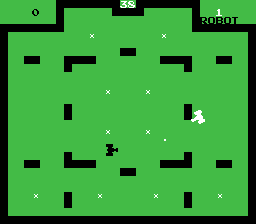 “Kee Games” (a shell company created by Atari founder Nolan Bushnell) introduces a new arcade game, a video war between two artillery commanders called Tank. The first video game to require each player to man two joysticks, designed to mimic real tank controls, Tank is later immortalized in the first pack-in launch title for the Atari VCS console, under the title of Combat.
“Kee Games” (a shell company created by Atari founder Nolan Bushnell) introduces a new arcade game, a video war between two artillery commanders called Tank. The first video game to require each player to man two joysticks, designed to mimic real tank controls, Tank is later immortalized in the first pack-in launch title for the Atari VCS console, under the title of Combat.
Space Race
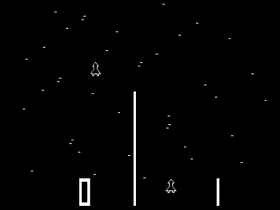 Atari releases its second arcade game: the very first video racing game, Space Race. Devised to fulfill a contractual game development obligation to rival manufacturer Bally Midway, the game is released by Midway under the title Asteroid, though Atari releases its own “clone” (of its own game) under the title Space Race on this date.
Atari releases its second arcade game: the very first video racing game, Space Race. Devised to fulfill a contractual game development obligation to rival manufacturer Bally Midway, the game is released by Midway under the title Asteroid, though Atari releases its own “clone” (of its own game) under the title Space Race on this date.
Pong
 Atari releases its first product, the arcade game Pong. A more refined version of the basic video ping pong game introduced by the Magnavox Odyssey, it’s simpler than Nolan Bushnell’s earlier attempt to put video games in public spaces (the complicated Computer Space), and is an engineering trial-by-fire for its designer, engineer Al Alcorn. The game is implemented with analog logic rather than an expensive (at the time) microchip, and is a success, ushering in the coin-op video game era to stay.
Atari releases its first product, the arcade game Pong. A more refined version of the basic video ping pong game introduced by the Magnavox Odyssey, it’s simpler than Nolan Bushnell’s earlier attempt to put video games in public spaces (the complicated Computer Space), and is an engineering trial-by-fire for its designer, engineer Al Alcorn. The game is implemented with analog logic rather than an expensive (at the time) microchip, and is a success, ushering in the coin-op video game era to stay.
Atari launched
 In Santa Clara, California, Atari is formed by Nolan Bushnell and Ted Dabney. The company is initially part of Bushnell’s desire to continue competing in the coin-operated game market, where he believes video games can take part of the market share from pinball, but consumer products are not far from Bushnell’s mind either: two weeks before Atari’s incorporation, he attends a Magnavox product fair and gets a first-hand look at the first home video game console.
In Santa Clara, California, Atari is formed by Nolan Bushnell and Ted Dabney. The company is initially part of Bushnell’s desire to continue competing in the coin-operated game market, where he believes video games can take part of the market share from pinball, but consumer products are not far from Bushnell’s mind either: two weeks before Atari’s incorporation, he attends a Magnavox product fair and gets a first-hand look at the first home video game console.
Computer Space
 Boasting a curved, futuristic fiberglass cabinet that truly looks like an alien art object, Nutting Associates’ arcade video game Computer Space hits an amusement market dominated by pinball machines and jukeboxes. Devised by Nolan Bushnell, Computer Space is a coin-operated homage to the mainframe game Spacewar, complete with complicated controls, and fails to sell well. Bushnell later has a revelation: arcade games will need to be easy to learn (but not easy to beat) in order to catch on.
Boasting a curved, futuristic fiberglass cabinet that truly looks like an alien art object, Nutting Associates’ arcade video game Computer Space hits an amusement market dominated by pinball machines and jukeboxes. Devised by Nolan Bushnell, Computer Space is a coin-operated homage to the mainframe game Spacewar, complete with complicated controls, and fails to sell well. Bushnell later has a revelation: arcade games will need to be easy to learn (but not easy to beat) in order to catch on.
More about Computer Space in Phosphor Dot Fossils
Hear about it on the Sci-Fi 5 podcast
The Brown Box
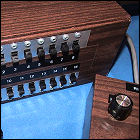 At Sanders Associates, Ralph Baer completes the sixth iteration of his recently-patented Television Gaming & Training Apparatus, now covered in brown woodgrain and called “The Brown Box.” Utilizing logic circuits and spot generators rather than a computer chip, the Brown Box is capable of playing video ping pong and other simple games. This is the prototype of the first mass-marketed home video game system. Sanders begins courting prospective licensees, including RCA, Zenith, General Electric, Motorola and Magnavox; companies already manufacturing television sets will be the corporate entites most likely to show an interest. RCA declines, but one of its executives, having seen the Brown Box demonstrated, later defects to Magnavox, which eventually licenses the Brown Box technology from Sanders. The result will be the Magnavox Odyssey, the first-ever home video game console.
At Sanders Associates, Ralph Baer completes the sixth iteration of his recently-patented Television Gaming & Training Apparatus, now covered in brown woodgrain and called “The Brown Box.” Utilizing logic circuits and spot generators rather than a computer chip, the Brown Box is capable of playing video ping pong and other simple games. This is the prototype of the first mass-marketed home video game system. Sanders begins courting prospective licensees, including RCA, Zenith, General Electric, Motorola and Magnavox; companies already manufacturing television sets will be the corporate entites most likely to show an interest. RCA declines, but one of its executives, having seen the Brown Box demonstrated, later defects to Magnavox, which eventually licenses the Brown Box technology from Sanders. The result will be the Magnavox Odyssey, the first-ever home video game console.
The ‘480 Patent
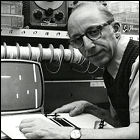 Ralph Baer files the first patent for his Television Gaming & Training Apparatus, United States patent #3,728,480. The patent is assigned to Baer’s employer, government contractor Sanders Associates, and is the first patent filed for the design of a video game. Though Baer will eventually build, and sell the design for, the first home video game, the real reward to be reaped from this patent will be licensing: every company manufacturing a video game console will have to pay Sanders and Baer for the privelege of expanding upon this basic patent, and it stands up in numerous court cases well into the 1980s as the “pioneer patent of the video game industry.”
Ralph Baer files the first patent for his Television Gaming & Training Apparatus, United States patent #3,728,480. The patent is assigned to Baer’s employer, government contractor Sanders Associates, and is the first patent filed for the design of a video game. Though Baer will eventually build, and sell the design for, the first home video game, the real reward to be reaped from this patent will be licensing: every company manufacturing a video game console will have to pay Sanders and Baer for the privelege of expanding upon this basic patent, and it stands up in numerous court cases well into the 1980s as the “pioneer patent of the video game industry.”
The day video games were born
 In a hand-written design document, Ralph Baer, an engineer working for defense contractor Sanders Associates, sketches out his ideas for a device he calls a TV Gaming Display. The design proposal lays out a concept to take television from being a passive form of entertainment to an interactive one in which two players can manipulate simple on-screen displays to play various games. Management at Sanders recognizes the potential of the invention, and Baer proceeds with development of the first video game prototypes, one of which becomes the basis for the first home video game console, the Magnavox Odyssey, six years later.
In a hand-written design document, Ralph Baer, an engineer working for defense contractor Sanders Associates, sketches out his ideas for a device he calls a TV Gaming Display. The design proposal lays out a concept to take television from being a passive form of entertainment to an interactive one in which two players can manipulate simple on-screen displays to play various games. Management at Sanders recognizes the potential of the invention, and Baer proceeds with development of the first video game prototypes, one of which becomes the basis for the first home video game console, the Magnavox Odyssey, six years later.
Spacewar!
 At the 1962 Open House held at the Massachusetts Institute of Technology, a student programming project is unveiled on the school’s new DEC PCP-1 computer. In an attempt to demonstrate the machine’s real-time processing power in a context that can be understood by the general public, Steve Russell and his cohorts allow visitors to play the first computer game, Spacewar. The product of months of design and hundreds of man-hours of coding, Spacewar allows two players to navigate their way around the gravity of a sun while trying to blow each other to bits (as displayed on a round oscilloscope). Never patented or copyrighted, Spacewar goes on to “inspire” countless copies, including one of the earliest coin-operated arcade video games, Computer Space.
At the 1962 Open House held at the Massachusetts Institute of Technology, a student programming project is unveiled on the school’s new DEC PCP-1 computer. In an attempt to demonstrate the machine’s real-time processing power in a context that can be understood by the general public, Steve Russell and his cohorts allow visitors to play the first computer game, Spacewar. The product of months of design and hundreds of man-hours of coding, Spacewar allows two players to navigate their way around the gravity of a sun while trying to blow each other to bits (as displayed on a round oscilloscope). Never patented or copyrighted, Spacewar goes on to “inspire” countless copies, including one of the earliest coin-operated arcade video games, Computer Space.
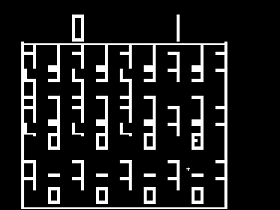 Atari releases its fourth arcade game: the very first video maze game,
Atari releases its fourth arcade game: the very first video maze game,